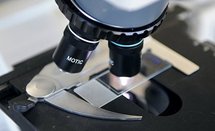Atom microscope is boon for materials science
AFP
PARIS- Materials scientists dream of one day being able to place a sample of unknown substance under a microscope and name individual atoms and the structure they form.
That vision of a tool able to analyse a material's atomic architecture or spot atoms that can damage a compound's strength or purity is a step nearer thanks to an exploit by scientists in the United States, the British journal Nature reports on Thursday.

The technique involves transmission electron microscopy, which sends a narrow beam of electrons through a wafer-thin sample.
Some of the electrons are scattered, depending on the density of the sample.
The unscattered ones strike a screen at the bottom of the microscope, creating a "shadow image" formed by interaction between the electrons with atoms in the sample.
The core technology in transmission electron microscopy dates back to 1931.
But getting an atom-by-atom image has been hampered by problems in getting electromagnetic lenses to focus the beam on the sample, and in damage to the sample caused by the electrons themselves.
The breakthrough stems from optics that correct the lens aberration and from a so-called annular dark-field method that is sensitive to the atomic number (the number of protons in the nucleus) of the imaged atoms, according to Nature.
The study is led by Ondrej Krivanek of Nion Co., a company based in Kirkland, Washington state, that specialises in electron microscopy.
German-born physicist Erwin Mueller is credited as the first person to see individual atoms, a feat he realised in 1955 using a field ion microscope.
------------------------------------------------------------------------------------